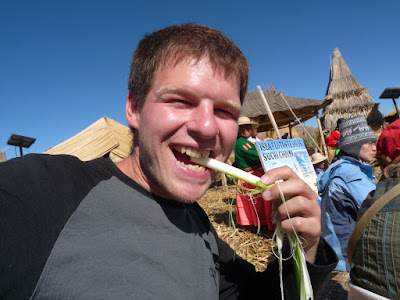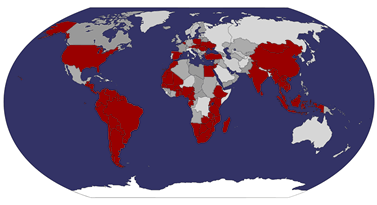But Peru was also a great country for vegetarian eating (as was Bolivia). There were plenty of vegetarian restaurants in the major cities, and plenty of corn, potatoes, quinoa, and churros in most places. Read on for a taste of Peru!
At the bus station on our very first day in Peru, Andy got this pastry. It's a cone filled with dulce de leche and coconut, making it pretty much Andy's ideal food.

The buses in Peru weren't the most luxurious, but one thing I liked is that at every stop, people would come on selling cheap, tasty, homemade treats. I bought a lot on our first day, such as this humita, which is like a sweet mini tamale, or cornmeal cake steamed in a corn husk (biodegradeable packaging!).

Also got these flatbread sandwich things that were stuck together with some sort of sweet goo. Not as good, but when it comes to bus snacks, you win some and you lose some.

In Arequipa, the bread often has a face in it. We thought the face might be some kind of edible candy, but when Andy bit into it, it turned out to be porcelain. I later asked at a marketplace "Por que hay cabezas en el pan?" ("Why are there heads in the bread?") and was told it had to do with a local holiday.

The national dish of Peru is lomo saltado, a stir-fry of beef, onions, tomatoes, and French fries, served with rice. We had many versions of this, including with beef and with alpaca, but my favorite was the vegan one we got at a vegetarian restaurant in Cuzco, featuring fake meat made out of gluten.

Peru's version of meat-on-a-stick comes with an excellent addition--a potato! Sometimes when I was feeling particularly vegetarian, Andy would eat the meat and I would eat the potato.

During our Sacred Valley tour, we stopped at a traditional bakery. Sabrina got a tasty baked empanada...

...and Andy bargained with the lady outside for this corn. Another popular street food in Peru is "choclo con queso," or corn on the cob with cheese. Andy didn't want the cheese, so he felt he should pay less for his corn. Finally, the lady gave in, but made him promise not to tell anyone about the special deal.

That same day, we found these tasty giant bananas with red skins at a convenience store. Stupidly, I thought they would be red inside, too, and was disappointed...but according to Andy and Sabrina, if I knew anything about how plants work, I would never have suspected this. Ah well, they were still tasty.

It was raining later that day, and Andy, Sabs, and I retired to a cafe where Andy ordered the purple corn desert. It turned out to be a dish of warm, sweet, purple liquid...a little strange, but not bad.

Remember Andy's post about the Uros floating islands in Lake Titicaca, where everything is made out of reeds? Well, they eat them, too. And so did we. Consistency is kind of like celery, but without the nasty celery taste.

One of our favorite drinks in Peru and Bolivia was jugo de quinoa, or quinoa juice. It is basically a thick apple cider-like drink with quinoa floating in it. It was actually even better, and cheaper, in Bolivia than in Peru, but we tried it first in Peru, where it usually cost about 80 centavos to 1 sol, or 25 to 35 cents, a glass.

Plenty of other drinks to be had on the street, too. Here I am at the border, returning from Bolivia, with a papaya drink that a lady blended up right in front of me.

Mmm, papas rellenas--potato balls stuffed with onions and meat and fried, our favorite street food in Arequipa. 80 centavos (25 cents) just outside the main market.

Inside the market, we saw several stalls selling frog juice. Yup, that's right. They throw a couple of live frogs in a blender with some water and sweeten to taste. Apparently it's supposed to make you smarter, but Andy and I prefered to remain stupid in this case.

Also from the Arequipa market, lucuma chip ice cream. You may remember lucuma from our Chile foods post--it's a squash that tastes like butterscotch, and is also popular in Peru. I also had lucuma yogurt in Peru, very nice.

The folks who sold papas rellenas in front of the market also sold these empanada-like stuffed savory pastries, filled with potatoes, meat, onions, and spices. Andy put way too much hot sauce on this one and almost asphyxiated when he ate it.

Churros! There were none in Bolivia, but we found them again in Arequipa and Lima. This is just a little bag of plain ones, not filled, but still sugar-coated and tasty.

We ate dinner in Arequipa in a little local hole in the wall that served us giant plates of stir-fried food from their wok for $1.50 each. I got lomo saltadao and Andy got this plate of tallarines (noodles with veggies and beef) and we shared.

My favorite street breakfast in Peru: a vegetable sandwich and a mug of quinoa juice. Here I have a sandwich with a strip of sweet potato in it; also delicious was the avocado sandwich. About 50 cents US, and vegan!

Decidedly not vegan: chicharones, which basically translates to fried stuff. This bag has a chunk of fried pork in it and some fried giant corn kernels.

Andy enjoyed some sandwiches too, like this beef one he bought on the bus from Nazca to Lima.

Lima turned out to be the churro capital of South America--there was a street right near our hostel (which I dubbed Churro Alley) where you could find three types of churros for sale at the same time from each vendor! You had your choice of a baggie of plain churros, a large dulce de leche-filled churro, or one of these special, giant, apple-filled churros, which are apparently called "churros of the Virgin del Carmen."
Now, I don't know a whole lot about Catholic saints, but if I had to pick a favorite, I would definitely pick the one that has her own churro!

Lima, while not always the most appealing city in other respects, also turned out to have amazing street food. There is an area beside the river in central Lima called Alameda Chabuca Granda where you can find stalls selling food from all parts of the country--it also has a kind of carnival atmosphere and was a great place to walk around at night.
Our very favorite thing that we found there was rice pudding. We always got a mixture of the white and brown pudddings (we think the brown had more spices and/or brown sugar in it) with some raisins, shredded coconut, and condensed milk drizzled on top. It was about $1 for a pint, which we would polish off between us in about 60 seconds.

Less exciting was this cold, gloopy pudding we tried. I made Andy eat most of it.

Picarones are rings of fried dough served in a sugary syrup. They looked too much like donuts for Andy to pass up.

One stall was selling two types of tamales--one kind (tamales verdes, the green one) popular in the north of Peru, and one (tamales criollos) from the south. We may have that backwards. In any case, they were stuffed with different things, and it was fun to taste and compare.

Ergh, we sort of struck out with this one. We thought it was a plate of mixed grilled meats, but actually turned out to be mostly intestines. Andy downed a bit of it, but we just didn't have the stomach to eat...well, stomach.

Much less scary was this cinnamon roll we shared the next day at the fancy mall of Larcomar, which is built into the cliffside in the posh Lima suburb of Miraflores. If you are shocked that Andy would share a cinnamon roll with anyone, please note that it is covered with cream cheese icing--he let me take care of the cheesy surfaces.

On our final night in Lima, Andy and I decided that we had to be brave and try the local dishes that had been consistently recommended to us by Peruvians.
So to that end, we went to a restaurant and I ordered an appetizer of ceviche, which is raw seafood marinated in something acidic that sort of "cooks" it. I don't really like seafood much, so I was hoping for a very small portion. I ended up with this mountain of shellfish:

Oops! I ate as much as I could, but that wasn't very much. I really didn't like it. Luckily, the restaurant had lured us in with the promise of a free pisco sour for each of us, and since Andy doesn't drink, they both went to me! This helped wash the icky seafood taste out of my mouth.

PS, pisco sours in Peru are different from those in Chile. In Peru, they are made with lime juice and egg whites (hence the foaminess) and are, in my experience, way less strong than the lemony Chilean ones.
Anyway, Andy got this fun stuffed pepper appetizer, not too adventurous.

But then, for his main course...
(look away now, Diane!)
Guinea pig! Actually, just 1/4 guinea pig (or "cuy" as it is called in Peru), which isn't much pig at all, but that's what all the restaurants serve. Andy said that what little meat there was to eat was OK, but that the skin was really thick and tough and unappetizing. We later mentioned this to a Peruvian tour guide in Huaraz, and he laughed and told us that we had got "an old one."

Note: For a much, much more fun/horrifying picture of cuy, please check out our friends Ben and Megan's blog post Lake Titicaca (hee hee!) ; it's the fifth picture down!
Well, that's it for foods of Peru. We didn't love those two national specialties, but we did love pretty much everything else we ate and drank on the streets and in restaurants. Eating out in both Peru and Bolivia was cheap, and it continues to be so in Ecuador, so we haven't actually cooked a meal since Chile...probably not so great for our health, but not hurting our wallets too much.


Ahh, lomo saltado... I kind of miss it! We're still loving the updates and now vicariously traveling through you guys, although it is good to be home! Can't wait to see you in January - perhaps a Fette Sau outing is in order?
ReplyDeleteOh my gosh!! I would probably starve there. I don't know why, but I followed that link to your friends blog and threw up in my mouth a little bit. My meat should NEVER look like the animal it came from. That was insane!!
ReplyDeleteI was so sad to see the frog juice picture. Poor little guys blended up alive, covered in sugar...
ReplyDeleteBut, I must try some quinoa juice at some point. Must. I wonder if it gives you a lot of protein?